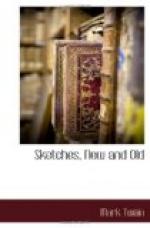In the course of time Fisher died, and his widow married again. And by and by, nearly twenty years after that dimly remembered raid upon Fisher’s corn-fields, the widow Fisher’s new husband petitioned Congress for pay for the property, and backed up the petition with many depositions and affidavits which purported to prove that the troops, and not the Indians, destroyed the property; that the troops, for some inscrutable reason, deliberately burned down “houses” (or cabins) valued at $600, the same belonging to a peaceable private citizen, and also destroyed various other property belonging to the same citizen. But Congress declined to believe that the troops were such idiots (after overtaking and scattering a band of Indians proved to have been found destroying Fisher’s property) as to calmly continue the work of destruction themselves; and make a complete job of what the Indians had only commenced. So Congress denied the petition of the heirs of George Fisher in 1832, and did not pay them a cent.
We hear no more from them officially until 1848, sixteen years after their first attempt on the Treasury, and a full generation after the death of the man whose fields were destroyed. The new generation of Fisher heirs then came forward and put in a bill for damages. The Second Auditor awarded them $8,873, being half the damage sustained by Fisher. The Auditor said the testimony showed that at least half the destruction was done by the Indians “before the troops started in pursuit,” and of course the government was not responsible for that half.
2. That was in April, 1848. In December, 1848, the heirs of George Fisher, deceased, came forward and pleaded for a “revision” of their bill of damages. The revision was made, but nothing new could be found in their favor except an error of $100 in the former calculation. However, in order to keep up the spirits of the Fisher family, the Auditor concluded to go back and allow interest from the date of the first petition (1832) to the date when the bill of damages was awarded. This sent the Fishers home happy with sixteen years’ interest on $8,873—the same amounting to $8,997.94. Total, $17,870.94.
3. For an entire year the suffering Fisher family remained quiet—even satisfied, after a fashion. Then they swooped down upon the government with their wrongs once more. That old patriot, Attorney-General Toucey, burrowed through the musty papers of the Fishers and discovered one more chance for the desolate orphans—interest on that original award of $8,873 from date of destruction of the property (1813) up to 1832! Result, $110,004.89 for the indigent Fishers. So now we have: First, $8,873 damages; second, interest on it from 1832 to 1848, $8997.94; third, interest on it dated back to 1813, $10,004.89. Total, $27,875.83! What better investment for a great-grandchild than to get the Indians to burn a corn-field for him sixty or seventy years before his birth, and plausibly lay it on lunatic United States troops?




